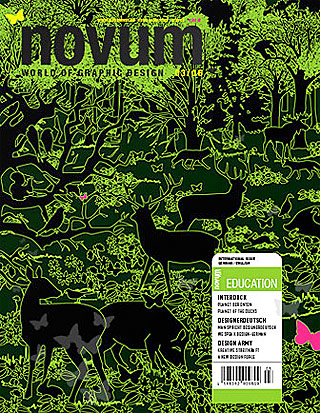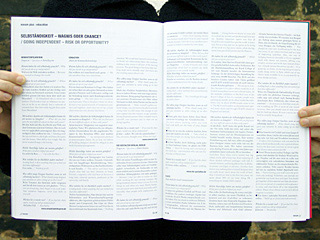PRESS ARCHIVE
Novum – World of Graphic Design, FL@33 interview as part of the Education special, Going Independent: Risk or Opportunity?, Selbständigkeit – Wagnis oder Chance?, pp.56–57, Munich, Germany, March 2006 (English and German)
___

NOVUM PLUS: EDUCATION | FL@33 INTERVIEW
ENGLISH | Why did you decide to go independent?
Going freelance meant we were able to control our private and professional lives better. Another important aspect was that all FL@33 work would then get the credit it deserved. For us it was just not an option to be doing all the work in a big-name studio, while the big-name boss got all the praise and the flowers.
Where did you set up on your own?
We set up in London, because it is a place where creativity is afforded tremendous social and cultural status. At the students' exhibition in the final year at the Royal College of Art,...
(...) CONTINUE READING
...for example, people were queuing up outside. In the three weeks the exhibition was on about 40,000 people came to see it. The RCA and London as a location have opened many doors and brought FL@33 clients in England and abroad.
What did you find were the most difficult aspects in those early years?
Cash-flow. Even when you've landed that big client, you're still a long way from replacing all those student software packages with full, licensed versions, and being able to buy in all those printer cartridges in advance. Another hard lesson was realising that a trained designer does not really know much about the world of business.I would say that in the first two years, we spent about 50% of our time doing PR - something we simply didn't expect.
What piece of advice helped you most?
You should do your own bookkeeping for the first two years, to see what's involved, and as a way of improving cash-flow. Also, one way of bridging financial shortfalls is if you negotiate deals with clients and printers, offering your creative services and work time instead of money. »Goods/service-for-service/goods« - it's a great tip, we think. At the beginning we used a really cheap server in Paris, which one of our clients made available to us, as payment for various design services.
Looking back, is there anything that you wished you had done differently?
As soon as you find that a main client is making up 35% or more of your annual turnover, then you should start to, look round fast for back-up clients. It's not a secret, but hard to actually bring about.
What should young designers pay attention to, when setting up on their own?
It takes a lot of patience and you need to be able to hold out financially over a period of time. And in the first years you have to invest a great deal of your time and private life!
___ News! Getting your stuff out to the press costs you nothing! Publishers and journals are grateful for any fresh ideas and input. You should get together all the material and data about projects you are proud of, complete with explanatory texts, and send them off to the responsible editors. Many of our clients came to us in direct response to articles.
___ Build up an (inter)national network.
If you had the choice again, would you still go independent?
Absolutely.
GERMAN | Warum haben Sie sich selbständig gemacht?
So haben wir größeren Einfluß auf Privat- und Berufsleben. Ein anderer wichtiger Aspekt war es, daß alle FL@33-Werke entsprechende 'credits' haben. Für uns stand es nicht zur Debatte, in einem namhaften Studio Arbeiten von A bis Z fertigzustellen, während der renommierte Boss das Schulterklopfen und die Blumen bekommt.
Wo haben Sie sich selbständig gemacht?
In London, denn hier hat Kreativität einen großen gesellschaftlich-kulturellen Stellenwert. Bei der Abschlußausstellung am Royal College of Art...
(...) CONTINUE READING
...zum Beispiel standen die Interessierten Schlange. Zu der dreiwöchigen Ausstellung kamen etwa 40.000 Besucher. Das RCA und der Standort London haben viele Türen geöffnet und FL@33 sowohl nationale als auch internationale Kunden gebracht.
Mit welchen Aspekten der Selbständigkeit hatten Sie am meisten zu kämpfen?
»Cash-flow«. Auch wenn der große Kunde vor der Tür steht, heißt das nicht, daß sofort alle Studenten-Softwarepakete mit legalen Firmenlizenzen ersetzt und die Druckerpatronen im Vorfeld bezahlt werden können. Eine weitere Ernüchterung war, daß man selbst als ausgebildeter Designer immer noch nicht viel von der Business-Seite weiß. Wir haben unerwartet etwa fünfzig Prozent der ersten zwei Jahre ausschließlich damit verbracht, PR zu betreiben.
Welche Ratschläge haben am meisten geholfen?
Man sollte die Buchhaltung die ersten zwei Jahre selber machen, um einen Überblick zu bekommen und den »Cash-flow« zu verbessern. Zweitens kann man finanzielle Engpässe überbrücken, indem man mit Kunden und Druckern Deals aushandelt und beispielsweise kreativen Service und Arbeitszeit statt Geld anbietet. »Goods/Service-for-Service/Goods« - ein Spitzentip, wie wir finden. Wir nutzten zum Beispiel am Anfang einen extrem günstigen Server in Paris, den ein Kunde, als Gegenleistung für diverse Designs, zur Verfügung stellte.
Was würden Sie im Rückblick anders machen?
Wenn ein Hauptkunde fünfunddreißig Prozent oder mehr des jährlichen Umsatzes einbringt, sollte man sich schnell nach Backup-Kunden umschauen. Kein Geheimnis, aber schwer umzusetzen!
Was sollten junge Designer beachten, wenn sie sich selbständig machen?
Man braucht viel Geduld und einen langen finanziellen Atem. Und in den ersten Jahren muß man sehr viel Zeit und Privatleben investieren!
___ News! Presse kostet nichts! Verleger und Magazine sind dankbar für frischen Wind und Input. Projekte, auf die man stolz ist, sollte man unverzüglich mit ordentlichen Feindaten und erklärenden Texten an die entsprechenden Personen schicken. Viele unserer Kunden kamen auf uns zu, nachdem Artikel abgedruckt wurden.
___ Ein (inter-) nationales Netzwerk zusammenstellen.
Würden Sie es wieder tun?
Jederzeit


